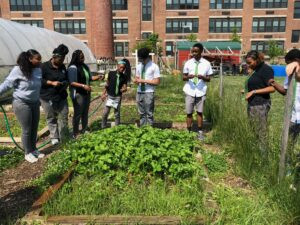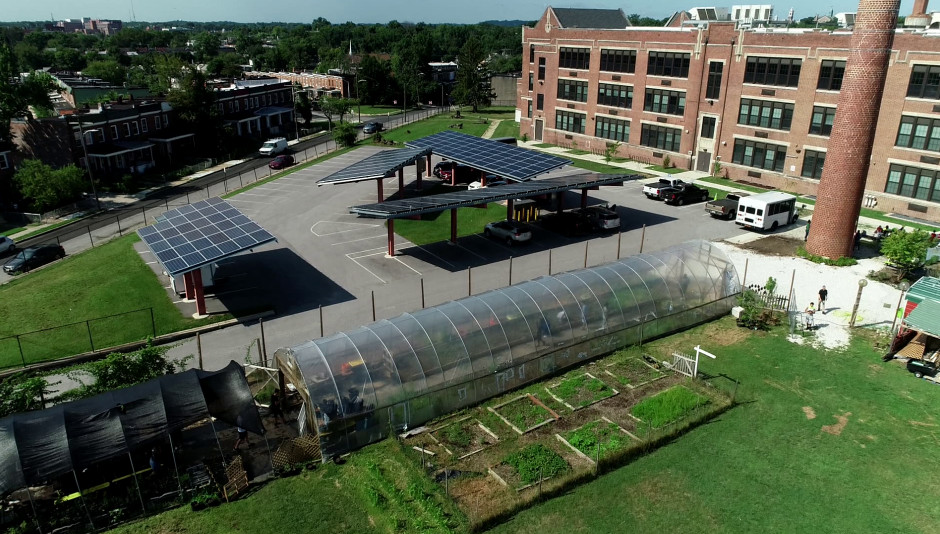“It’s a running joke here, but honestly, most of what we grow never leaves the farm because our students love to eat it all,” laughs Eric Oberlecher, the Farm Manager at Green Street Academy, located in Baltimore, Maryland.
 Students learning about urban farming at Green Street Academy in Baltimore
Students learning about urban farming at Green Street Academy in Baltimore
Green Street Academy stands out as a public charter school for grades 6-12, uniquely centered around sustainability. A cornerstone of this mission is their thriving school farm. High school students actively manage this farm as part of their urban agriculture and aquaculture curriculum during the school year. Beyond the classroom, these students gain valuable hands-on experience as paid interns on the farm throughout the summer months.
Eric proudly recounts the transformation of the land, stating, “Less than five years ago, this area was a derelict industrial site. We’ve revitalized the property, bringing it back to life through agriculture and education.”
The farm program at Green Street Academy received a significant boost from the Brighter Future Fund. This grant provided crucial resources, including seeds and essential equipment, ensuring the continuation and expansion of their agricultural education initiatives for another year. The Brighter Future Fund, an initiative by American Farmland Trust in partnership with Tillamook Creamery, is dedicated to supporting farmers as they navigate critical challenges such as climate change and the ongoing impacts of events like COVID-19.
Student involvement at Green Street Academy extends beyond the daily tasks of planting, nurturing, and harvesting crops, and caring for livestock. They are integral to the farm’s development, collaborating with Eric on the design and construction of key infrastructure elements. This includes building a hoop house, essential for extending the growing season, and innovative hydroponics systems housed in repurposed shipping containers.
“While I understand that not all of my students will pursue careers as farmers,” Eric explains, “managing this farm provides them with an incredibly diverse skill set. It’s not just about farming; they become plant scientists, learn basic electrical work, and develop essential entrepreneurial skills.”
Expanding on this multifaceted learning experience, Eric adds, “Our students are even learning to code.” During the academic year, students delve into the technology behind modern agriculture by coding “food computers.” These systems are designed to precisely regulate environmental factors such as temperature and light levels, optimizing growing conditions within controlled environments.
 Aerial view of Green Street Academy farm showcasing urban agriculture learning oasis in Baltimore
Aerial view of Green Street Academy farm showcasing urban agriculture learning oasis in Baltimore
Through their dedicated efforts, the students have transformed the school grounds into a vibrant and productive agricultural learning center. The Green Street Academy farm now boasts a diverse range of agricultural features, including a native plant nursery to support local biodiversity, a hoop house for year-round growing, a flourishing orchard, a chicken coop for poultry farming, an aquaculture lab for fish cultivation, and an advanced hydroponics system. The fresh produce and products from the farm are utilized within the school’s cafeteria, and a significant portion is sold or donated to benefit the wider Baltimore community, fostering local food access and community engagement.
Eric emphasizes that a core tenet of Green Street Academy’s mission is to instill a deep understanding of sustainability. This extends beyond preparing students for careers in technology-driven sustainability fields. The program aims to embed sustainable practices and a sense of environmental responsibility within the students and to ripple outwards into the surrounding community. “We are committed to equipping students with the stewardship skills necessary to actively shape their communities, creating environments that reflect the aspirations of both the students and their neighbors,” he concludes.
